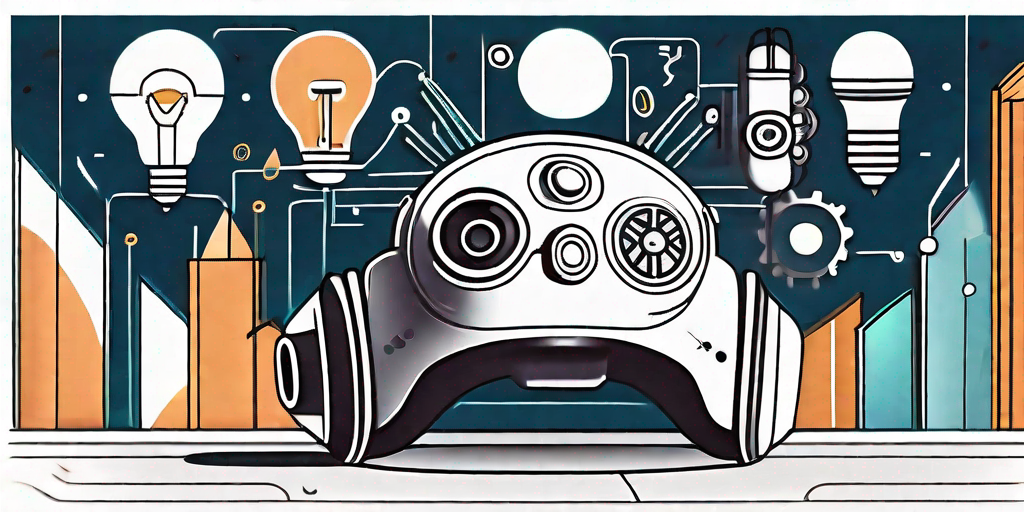Understand Virtual Reality with the Help of an Innovation Speaker

Understand Virtual Reality with the Help of an Innovation Speaker
Virtual reality (VR) has been a topic of fascination and excitement in recent years. As the technology continues to evolve and improve, the possibilities for its applications are vast and intriguing. However, for many people, understanding the intricacies of virtual reality can be a daunting task. This is where an innovation speaker can be instrumental in simplifying and demystifying VR, making it accessible to all. In this article, we will delve into the fundamentals of virtual reality and explore the role of an innovation speaker in helping us comprehend and leverage this transformative technology.
Understanding the Basics of Virtual Reality
Before we can fully grasp the impact of virtual reality, we need to understand its foundational elements. At its core, virtual reality is a simulated experience that can be similar to or completely different from the real world. It typically involves the use of a VR headset that immerses the user in a computer-generated environment, often accompanied by specialized audio and haptic feedback devices. This combination of visual, auditory, and tactile stimuli creates a sense of presence, transporting users to alternative realities and enabling them to interact with virtual objects and environments.
Virtual reality relies on cutting-edge technologies such as motion tracking, 3D graphics, and head-mounted displays to create a convincing and immersive experience. By tricking our senses, VR has the potential to transport us to faraway places, simulate realistic scenarios, or even explore imaginary worlds.
Let's delve deeper into the technologies that make virtual reality possible. Motion tracking is a crucial component of VR, as it allows the system to track the user's movements and adjust the virtual environment accordingly. This is achieved through the use of sensors, cameras, or infrared light, which capture the user's position and orientation in real-time. By accurately tracking the user's head movements, the VR system can update the displayed visuals accordingly, creating a seamless and immersive experience.
In addition to motion tracking, 3D graphics play a vital role in virtual reality. These graphics are responsible for creating the virtual environments and objects that users interact with. By utilizing advanced rendering techniques, such as shading, texturing, and lighting, VR can generate realistic and detailed visuals that mimic the real world. Whether it's exploring ancient ruins, diving into the depths of the ocean, or even venturing into outer space, the power of 3D graphics in virtual reality is truly awe-inspiring.
Head-mounted displays (HMDs) are another essential component of virtual reality. These devices are worn on the user's head and consist of a high-resolution display for each eye. The displays are positioned close to the user's eyes, providing a wide field of view and creating a sense of immersion. Some HMDs also incorporate additional features like eye-tracking technology, which allows for more precise interaction within the virtual environment. With the continuous advancements in HMD technology, VR experiences are becoming increasingly lifelike and engaging.
Virtual reality wouldn't be complete without audio and haptic feedback. Sound plays a crucial role in enhancing the sense of presence and immersion. By using spatial audio techniques, VR can create realistic soundscapes that accurately reflect the user's virtual surroundings. This adds another layer of depth to the virtual experience, making it more believable and captivating.
Haptic feedback devices, such as gloves or controllers, provide users with a sense of touch in the virtual world. These devices can simulate the feeling of texture, weight, and even resistance, allowing users to interact with virtual objects in a more natural and intuitive way. Imagine reaching out and feeling the texture of a virtual object or experiencing the resistance when pulling a virtual lever. Haptic feedback brings a whole new level of realism to virtual reality, making it an incredibly immersive and interactive medium.
As virtual reality continues to evolve, so does its potential. From entertainment and gaming to education and training, VR is finding its way into various industries and applications. The ability to create realistic simulations and immersive experiences opens up a world of possibilities. Imagine medical students practicing surgeries in a virtual operating room, architects walking through virtual buildings before they are constructed, or even astronauts training for space missions in virtual environments that mimic the conditions they will face. The potential of virtual reality is limitless.
The Role of an Innovation Speaker in Simplifying Virtual Reality
With such advanced technology, it's understandable that many individuals find it challenging to navigate the intricacies of virtual reality. This is where an innovation speaker comes in. An innovation speaker is someone who not only possesses a deep understanding of VR but also excels at effectively communicating complex concepts in a relatable and understandable manner.
Through their expertise and engaging presentations, innovation speakers break down the core principles of virtual reality and highlight its immense potential. They utilize their wealth of knowledge to provide real-life examples and relatable analogies, making the technology more approachable and less intimidating to the average person.
Imagine attending a conference where an innovation speaker takes the stage. As they begin their presentation, you are immediately captivated by their enthusiasm and passion for virtual reality. They start by explaining the fundamental concept of VR, describing how it creates a simulated environment that can be similar to or completely different from the real world.
But it doesn't stop there. The innovation speaker goes on to share fascinating examples of how virtual reality is being used across various industries. They talk about how VR is revolutionizing the field of healthcare, allowing medical professionals to practice complex surgeries in a safe and controlled environment. They discuss how architects and designers are utilizing VR to create immersive virtual walkthroughs of buildings and spaces, enabling clients to experience their designs before construction even begins.
The innovation speaker also dives into the entertainment industry, highlighting how virtual reality is transforming the way we consume media. They talk about the immersive experiences offered by VR gaming, where players can step into a different world and interact with their surroundings in ways never before possible. They mention how VR is being used in filmmaking to create breathtaking 360-degree videos, giving viewers a truly immersive and interactive cinematic experience.
As the innovation speaker continues, they address the concerns and misconceptions surrounding virtual reality. They explain that while VR can indeed be an intense and mind-blowing experience, it is designed to be safe and enjoyable for users. They emphasize the importance of responsible usage and the need for proper guidelines to ensure a positive virtual reality experience.
Throughout the presentation, the innovation speaker engages the audience with interactive demonstrations. They invite volunteers to try out VR headsets and experience firsthand the wonders of virtual reality. This hands-on approach allows attendees to feel more connected to the technology and sparks their curiosity to explore further.
By bridging the gap between the technical jargon and everyday language, innovation speakers enable individuals from all walks of life to appreciate and comprehend virtual reality. They effectively convey the practical benefits and limitless possibilities of VR, instilling a sense of curiosity and excitement in their audience.
Exploring the Applications of VR Technology
Virtual reality holds immense promise across various industries, from healthcare and education to entertainment and business. The ability to create immersive and interactive experiences opens up novel opportunities for training, therapy, design, and countless other sectors.
For instance, in healthcare, VR is revolutionizing patient care by providing realistic simulations for surgical training and pain management therapies. Surgeons can now practice complex procedures in a virtual environment, allowing them to refine their skills and improve patient outcomes. Additionally, VR is being used for pain management, where patients can be transported to calming and soothing virtual environments, helping to alleviate their discomfort and promote relaxation.
In education, virtual reality allows students to explore historical events or scientific phenomena that would otherwise be inaccessible. Imagine being able to step into the shoes of a historical figure and witness pivotal moments in history firsthand. VR can transport students to ancient civilizations, outer space, or even the microscopic world, providing a level of engagement and understanding that traditional textbooks simply cannot match. This immersive learning experience not only enhances retention but also fosters curiosity and a love for learning.
In the business realm, VR facilitates virtual meetings, product prototyping, and immersive marketing experiences, transforming the way organizations operate and engage with their customers. With VR, teams can collaborate in a virtual space, regardless of their physical locations, saving time and resources. Product designers can create virtual prototypes, allowing them to test and refine their designs before investing in physical production. Moreover, VR offers marketers the opportunity to create immersive brand experiences, where customers can interact with products or explore virtual showrooms, leading to increased engagement and brand loyalty.
An innovation speaker brings these applications to life, showcasing how virtual reality can enhance our lives in ways we might not have imagined. Through vivid illustrations and compelling case studies, they illustrate how this technology is not just a novelty but a powerful tool that can drive innovation and propel industries forward.
Furthermore, VR is also making waves in the field of architecture and urban planning. Architects can now create virtual walkthroughs of their designs, allowing clients to experience the space before it is built. This not only helps in visualizing the final product but also enables architects to make informed decisions regarding layout, lighting, and materials.
In the field of sports, VR is being used to enhance athlete training and performance analysis. Athletes can practice in virtual environments that mimic real game scenarios, helping them improve their skills and decision-making abilities. Coaches and trainers can also use VR to analyze player performance, identifying strengths and weaknesses, and developing personalized training programs.
Moreover, VR is being utilized in the field of psychology and mental health. Therapists can use virtual reality to create controlled environments for exposure therapy, helping patients overcome phobias and anxieties. VR is also being explored as a tool for treating post-traumatic stress disorder (PTSD), allowing patients to safely revisit traumatic events and gradually process their emotions.
As technology continues to advance, the possibilities for VR applications are only limited by our imagination. From architecture and sports to psychology and beyond, virtual reality is transforming industries and revolutionizing the way we experience the world.
How an Innovation Speaker Demystifies Virtual Reality
Demystifying virtual reality is no small feat, but it is precisely what an innovation speaker excels at. By employing a combination of clear and concise explanations, relatable anecdotes, and hands-on demonstrations, they effectively debunk the myths and misconceptions surrounding VR.
One of the key challenges in understanding virtual reality is reconciling its technological intricacies with its practical applications. An innovation speaker adeptly connects the dots, ensuring that their audience comprehends both the underlying technology and the tangible benefits it can bring.
Moreover, an innovation speaker goes beyond the theoretical aspects of VR and dives into the experiential dimension. By allowing the audience to try out virtual reality themselves, either through hands-on workshops or interactive demonstrations, they provide a firsthand sensory experience that solidifies understanding and fosters a sense of awe and excitement.
Leveraging Virtual Reality for Business Development
While virtual reality may seem like an abstract concept, it holds significant potential for business development and growth. An innovation speaker can help organizations harness the power of VR to drive innovation and gain a competitive edge.
From product design and prototyping to marketing and customer engagement, virtual reality offers businesses new avenues for creativity and exploration. The immersive nature of VR enables companies to showcase their offerings in ways that were once unimaginable, leaving a lasting impact on potential customers.
By providing insights into successful VR initiatives and sharing practical strategies for implementation, an innovation speaker equips businesses with the knowledge and motivation to embrace virtual reality as a catalyst for growth.
Conclusion
Virtual reality has the potential to revolutionize the way we live, work, and play. While the concept may initially seem complex and inaccessible, with the help of an innovation speaker, we can navigate this transformative technology and unlock its vast possibilities. Their ability to articulate the fundamentals, illustrate the practical applications, and dispel misconceptions makes virtual reality more approachable to individuals from all walks of life. As we continue to delve deeper into the world of virtual reality, let's embrace the guidance of innovation speakers who can illuminate our path and enable us to fully understand and leverage this incredible technology.
FAQ
1. What is virtual reality?
Virtual reality is a simulated experience that can be similar to or completely different from the real world. It involves the use of a VR headset that immerses the user in a computer-generated environment, creating a sense of presence and enabling interaction with virtual objects and environments.
2. How does virtual reality work?
Virtual reality relies on technologies such as motion tracking, 3D graphics, head-mounted displays, audio, and haptic feedback. Motion tracking allows the system to track the user's movements and adjust the virtual environment accordingly. 3D graphics create the virtual environments and objects, while head-mounted displays provide a wide field of view and immersion. Audio enhances the sense of presence, and haptic feedback devices simulate touch in the virtual world.
3. What are the applications of virtual reality?
Virtual reality has applications in various industries, including healthcare, education, entertainment, business, architecture, sports, and psychology. It can be used for surgical training, pain management therapies, immersive learning experiences, virtual meetings, product prototyping, marketing experiences, athlete training, mental health treatments, and more.
Contact a Innovation Speaker for your event
After reading about the transformative potential of virtual reality and the pivotal role an innovation speaker plays in demystifying this technology, you might be considering inviting an expert to your next event. Dr Mark van Rijmenam, a renowned innovation speaker, is equipped with the knowledge, passion, and charisma to engage your audience and make complex concepts like virtual reality accessible and exciting. He will not only explain the intricacies of VR but also showcase its practical applications across various industries. By inviting Dr van Rijmenam to your event, you can ensure an enlightening and inspiring experience for your audience. To book Dr van Rijmenam for your next event, simply complete the form below and we will be in touch within 24 hours. Don't miss this opportunity to explore the limitless possibilities of virtual reality with an expert guide.
Thanks for your inquiry
We have sent you a copy of your request and we will be in touch within 24 hours on business days.
If you do not receive an email from us by then, please check your spam mailbox and whitelist email addresses from @thedigitalspeaker.com.
In the meantime, feel free to learn more about The Digital Speaker here.
Or read The Digital Speaker's latest articles here.





